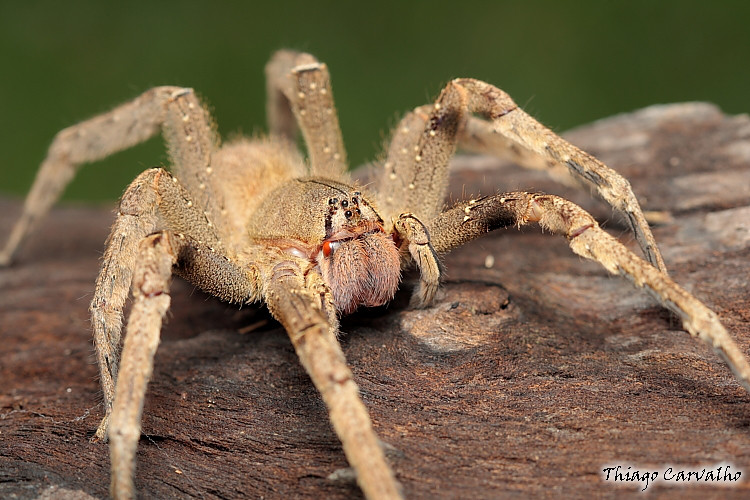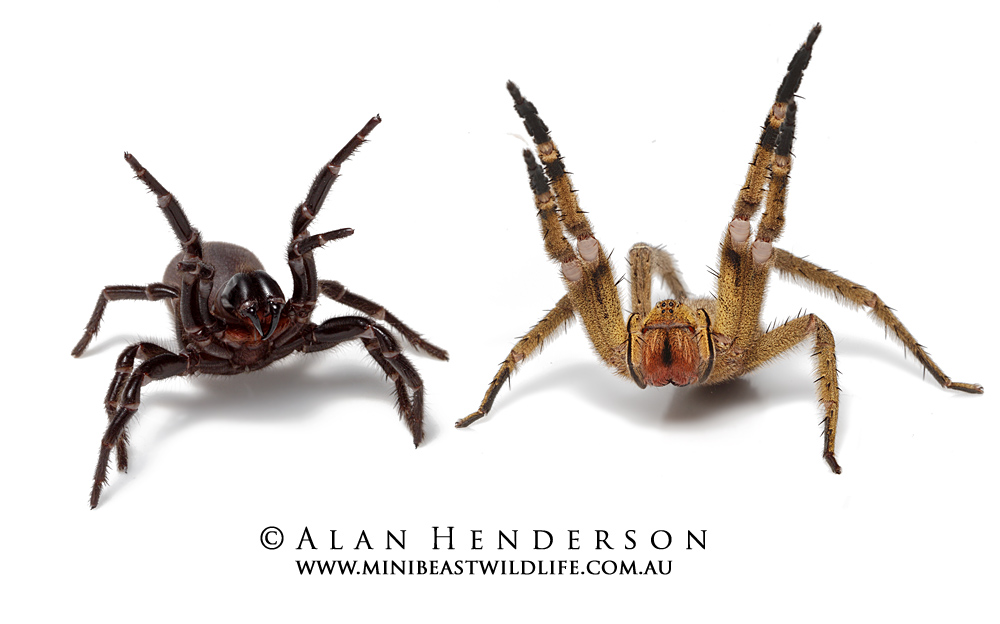Post by An Goldish Jade on Mar 5, 2016 10:58:39 GMT 5
Brazilian wandering spider-Phoneutria fera

Phoneutria (Ancient Greek for "murderess") contains eight scientifically described species; the most notorious being P. fera and P. nigriventer. The spiders in the genus can grow to have a leg span of 13 to 15 cm (5.1 to 5.9 in). Their body length ranges from 17 to 48 mm (0.67 to 1.89 in). While some other araneomorph spiders have a longer leg span, the largest Phoneutria species have the longest body and the greatest body weight in this group. The genus is distinguished from other related genera such as Ctenus by the presence of dense prolateral scopulae (a dense brush of fine hairs) on the pedipalp tibiae and tarsi in both sexes.Phoneutria are easily confused with several other non-medically significant ctenids, especially Cupiennius, in which the recently described C. chiapanensis also has bright red hairs on the chelicerae. Additionally, some Phoneutria species lack red hairs on the chelicerae, making it an unreliable identification feature. The presence of a dark linear stripe or stripes on the frontal (dorsal) palps and presence of a single thin black line running anterior-posterior along the dorsal carapace may help identify Phoneutria. Other features are the strong ventral marking on the underside of the legs with contrasting dark mid-segments and lighter joints, and the pattern on the ventral (underside) of the abdomen with several rows of black dots, or an overall reddish colour.
The characteristic defensive posture with frontal legs held high is an especially good indicator to confirm a specimen is Phoneutria,[6] especially alongside correct colour patterns. During the defensive display the body is lifted up into an erect position, the first two pairs of legs are lifted high (revealing the conspicuous black/light-banded pattern on the leg underside), while the spider sways from side to side with hind legs in a cocked position., commonly known as Brazilian wandering spiders, armed spiders ("armadeiras", as they are known in Brazilian Portuguese), or banana spiders (a name shared with several others), are a genus of aggressive and venomous spiders of potential medical significance to humans. They are mainly found in tropical South America, with one species in Central America. These spiders are members of the family Ctenidae of wandering spiders.
The Brazilian wandering spiders appear in Guinness World Records from 2010 as the world's most venomous spider. Guinness World Records states that although the Brazilian wandering spider venom is the most toxic, an effective antivenom is available and few fatalities occur.
Sydney Funnel-web Spider - Atrax robustus

The Sydney funnel-web spider (Atrax robustus) is a species of Australian funnel-web spider usually found within a 100 km (62 mi) radius of Sydney, New South Wales, Australia. It is a venomous mygalomorph spider with a bite capable of causing serious injury or death in humans if left untreated.
it is an medium to large spider, with body length ranging from 1 to 5 cm (0.4 to 2 in). Both sexes are glossy and darkly coloured, ranging from blue-black, to black, to brown or dark-plum coloured. The carapace covering the cephalothorax is almost hairless and appears smooth and glossy. Another characteristic are finger-like spinnerets at the end of their abdomen. The shorter-lived male is smaller than the female but longer legged. The average leg length for the spider in general is six to seven centimeters.
Sydney funnel-web spiderare mostly terrestrial spiders, favouring habitats with moist sand and clays. They typically build silk-lined tubular burrow retreats with collapsed "tunnels" or open "funnel" entrances from which irregular trip-lines radiate over the ground. In some exceptions, which lack trip-lines but may have trapdoors, the silk entrance tube may be split into two openings, in a Y or T form. Sydney funnel-webs burrow in sheltered habitats where they can find a moist and humid climate, for instance under rocks, logs or borer holes in rough-barked trees. The burrow may be in the hollow of a tree trunk or limb, many metres above ground level.[citation needed] The long-lived female funnel-webs spend most of the time in their silk-lined tubular burrow retreats. When potential prey, which includes insects, lizards or frogs, walks across the trip-lines, they rush out, subduing their prey by injecting their venom. Males, recognized by the modified terminal segment of the palp, tend to wander during the warmer months of the year, looking for receptive females to mate with. This makes encounters with male specimens more likely as they sometimes wander into backyards or houses, or fall into swimming pools. The spiders can survive such immersion for up to twenty-four hours, trapping air bubbles on hairs around their abdomen. The spiders are mainly active at night, as typical day-time conditions would dehydrate them. During the day, they seek cover in cool, moist hideaways. After heavy rain, spider activity is increased as their burrows may be flooded. When threatened or provoked, funnel-web spiders will display aggressive behaviour, rearing up on their hind legs and displaying their fangs. When biting, the funnel-web spiders maintain a tight grip on their victim, often biting repeatedly.

Phoneutria (Ancient Greek for "murderess") contains eight scientifically described species; the most notorious being P. fera and P. nigriventer. The spiders in the genus can grow to have a leg span of 13 to 15 cm (5.1 to 5.9 in). Their body length ranges from 17 to 48 mm (0.67 to 1.89 in). While some other araneomorph spiders have a longer leg span, the largest Phoneutria species have the longest body and the greatest body weight in this group. The genus is distinguished from other related genera such as Ctenus by the presence of dense prolateral scopulae (a dense brush of fine hairs) on the pedipalp tibiae and tarsi in both sexes.Phoneutria are easily confused with several other non-medically significant ctenids, especially Cupiennius, in which the recently described C. chiapanensis also has bright red hairs on the chelicerae. Additionally, some Phoneutria species lack red hairs on the chelicerae, making it an unreliable identification feature. The presence of a dark linear stripe or stripes on the frontal (dorsal) palps and presence of a single thin black line running anterior-posterior along the dorsal carapace may help identify Phoneutria. Other features are the strong ventral marking on the underside of the legs with contrasting dark mid-segments and lighter joints, and the pattern on the ventral (underside) of the abdomen with several rows of black dots, or an overall reddish colour.
The characteristic defensive posture with frontal legs held high is an especially good indicator to confirm a specimen is Phoneutria,[6] especially alongside correct colour patterns. During the defensive display the body is lifted up into an erect position, the first two pairs of legs are lifted high (revealing the conspicuous black/light-banded pattern on the leg underside), while the spider sways from side to side with hind legs in a cocked position., commonly known as Brazilian wandering spiders, armed spiders ("armadeiras", as they are known in Brazilian Portuguese), or banana spiders (a name shared with several others), are a genus of aggressive and venomous spiders of potential medical significance to humans. They are mainly found in tropical South America, with one species in Central America. These spiders are members of the family Ctenidae of wandering spiders.
The Brazilian wandering spiders appear in Guinness World Records from 2010 as the world's most venomous spider. Guinness World Records states that although the Brazilian wandering spider venom is the most toxic, an effective antivenom is available and few fatalities occur.
Sydney Funnel-web Spider - Atrax robustus

The Sydney funnel-web spider (Atrax robustus) is a species of Australian funnel-web spider usually found within a 100 km (62 mi) radius of Sydney, New South Wales, Australia. It is a venomous mygalomorph spider with a bite capable of causing serious injury or death in humans if left untreated.
it is an medium to large spider, with body length ranging from 1 to 5 cm (0.4 to 2 in). Both sexes are glossy and darkly coloured, ranging from blue-black, to black, to brown or dark-plum coloured. The carapace covering the cephalothorax is almost hairless and appears smooth and glossy. Another characteristic are finger-like spinnerets at the end of their abdomen. The shorter-lived male is smaller than the female but longer legged. The average leg length for the spider in general is six to seven centimeters.
Sydney funnel-web spiderare mostly terrestrial spiders, favouring habitats with moist sand and clays. They typically build silk-lined tubular burrow retreats with collapsed "tunnels" or open "funnel" entrances from which irregular trip-lines radiate over the ground. In some exceptions, which lack trip-lines but may have trapdoors, the silk entrance tube may be split into two openings, in a Y or T form. Sydney funnel-webs burrow in sheltered habitats where they can find a moist and humid climate, for instance under rocks, logs or borer holes in rough-barked trees. The burrow may be in the hollow of a tree trunk or limb, many metres above ground level.[citation needed] The long-lived female funnel-webs spend most of the time in their silk-lined tubular burrow retreats. When potential prey, which includes insects, lizards or frogs, walks across the trip-lines, they rush out, subduing their prey by injecting their venom. Males, recognized by the modified terminal segment of the palp, tend to wander during the warmer months of the year, looking for receptive females to mate with. This makes encounters with male specimens more likely as they sometimes wander into backyards or houses, or fall into swimming pools. The spiders can survive such immersion for up to twenty-four hours, trapping air bubbles on hairs around their abdomen. The spiders are mainly active at night, as typical day-time conditions would dehydrate them. During the day, they seek cover in cool, moist hideaways. After heavy rain, spider activity is increased as their burrows may be flooded. When threatened or provoked, funnel-web spiders will display aggressive behaviour, rearing up on their hind legs and displaying their fangs. When biting, the funnel-web spiders maintain a tight grip on their victim, often biting repeatedly.




 , the Wander according to the picture, have longer and more robust limbs, while the image could be inaccurate in comparsion, the Brazilian Wandering Spider being an Wandering Hunter, it would have greater agility, this advantage, combined with longer limbs, increase the chance for it to avoid been bitten, and just like the Funnel Web, it could end this fight in one bite.
, the Wander according to the picture, have longer and more robust limbs, while the image could be inaccurate in comparsion, the Brazilian Wandering Spider being an Wandering Hunter, it would have greater agility, this advantage, combined with longer limbs, increase the chance for it to avoid been bitten, and just like the Funnel Web, it could end this fight in one bite.